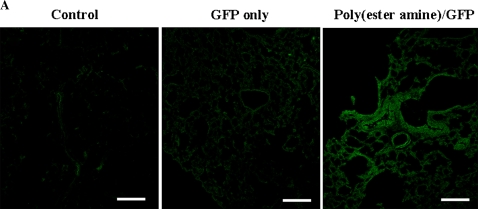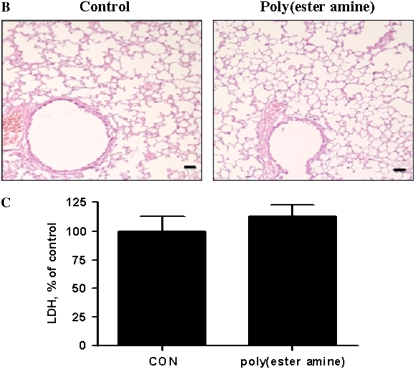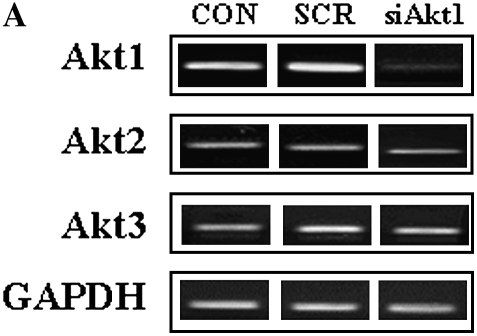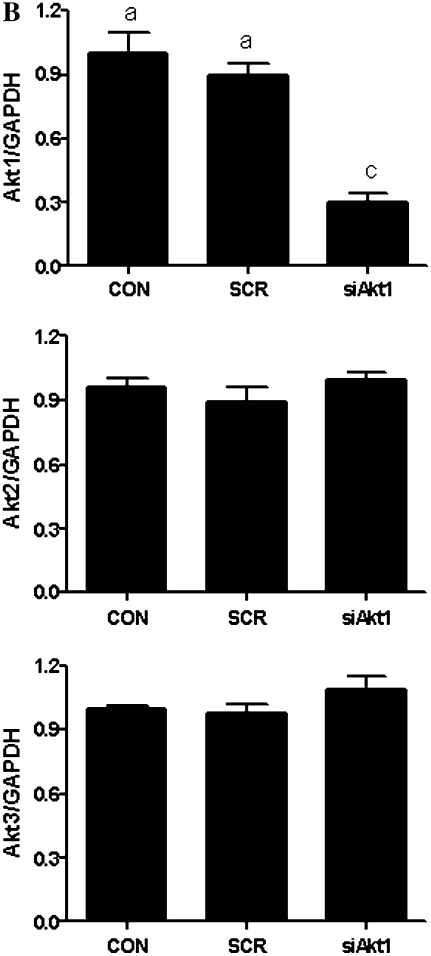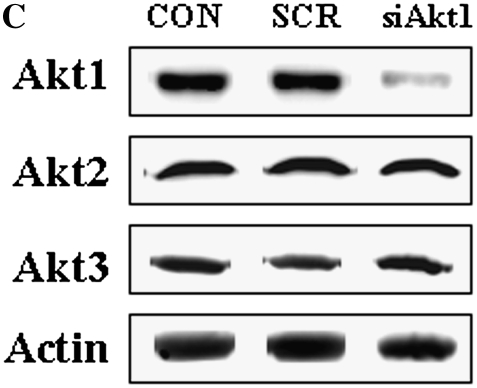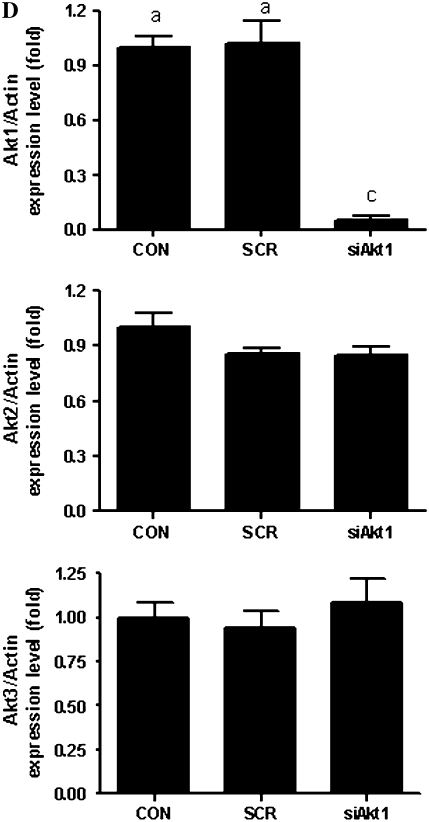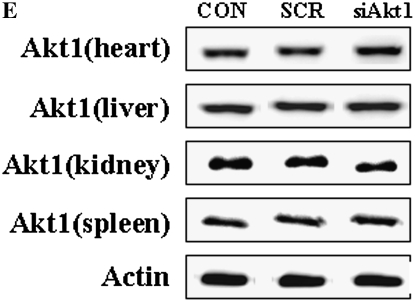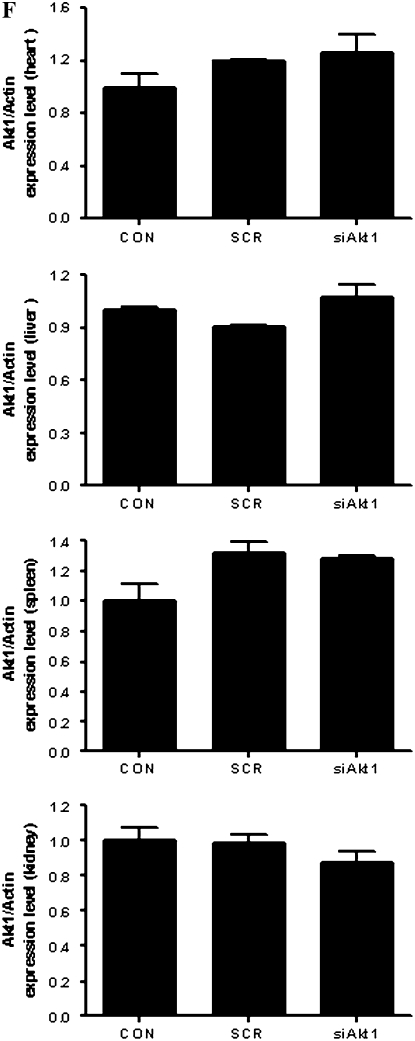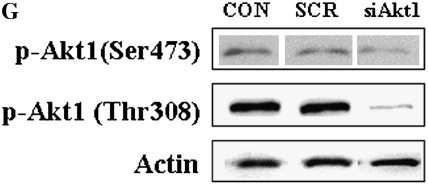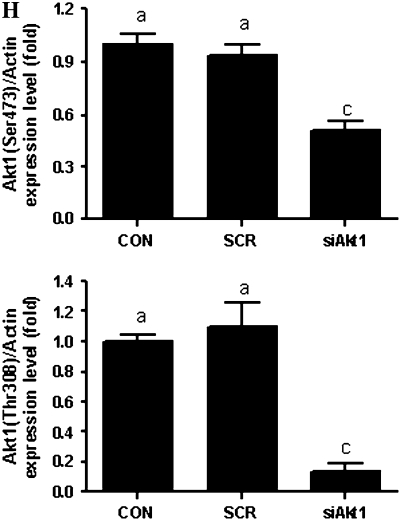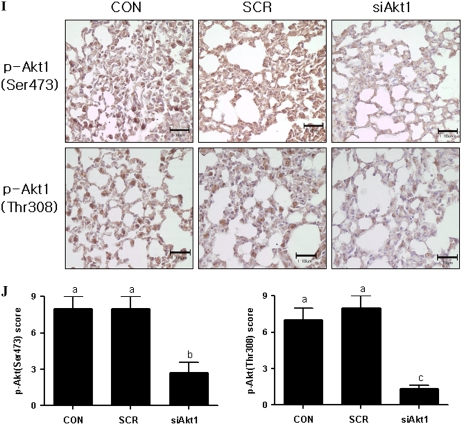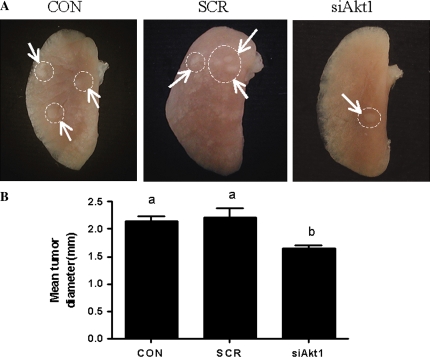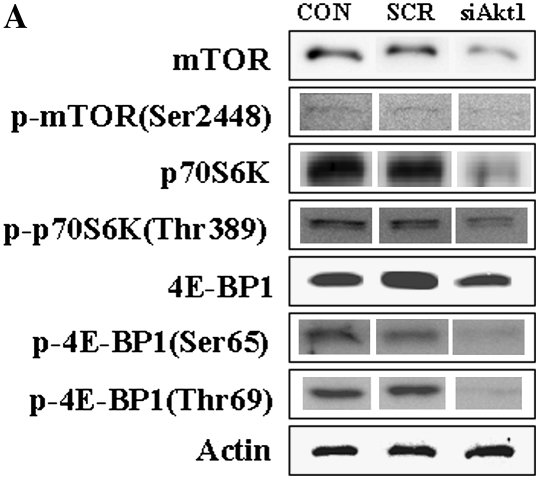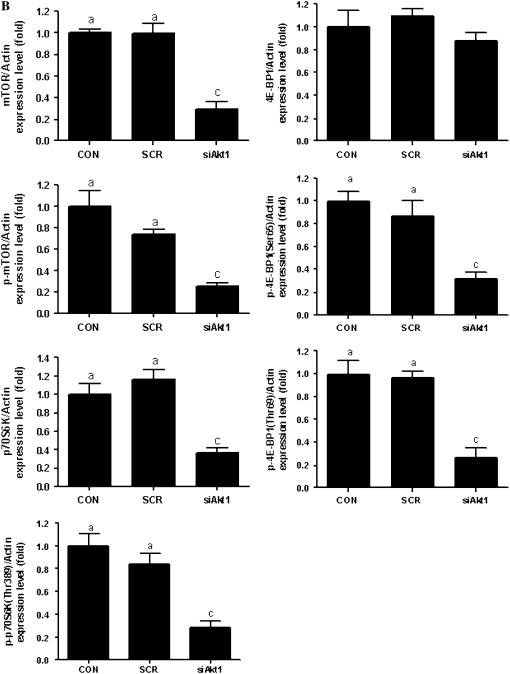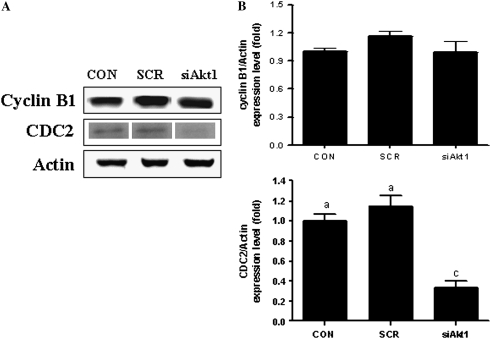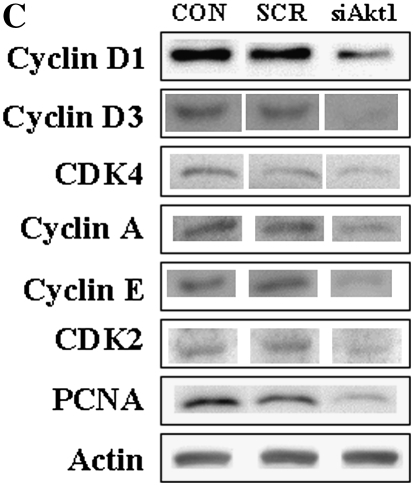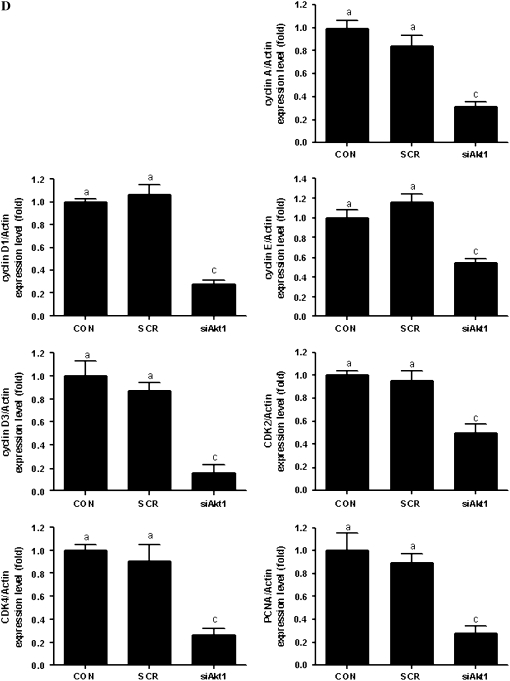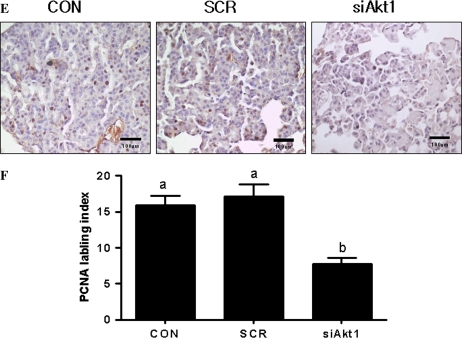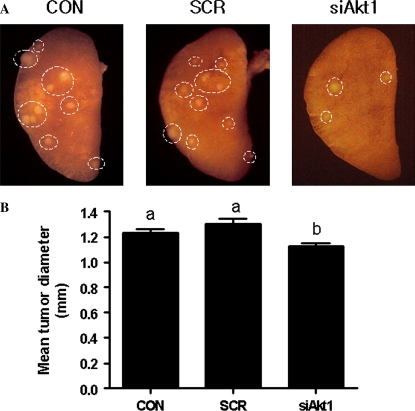Abstract
Rationale: The low efficiency of conventional therapies in achieving long-term survival of patients with lung cancer calls for the development of novel therapeutic options. Recent advances in aerosol-mediated gene delivery have provided the possibility of an alternative for the safe and effective treatment of lung cancer.
Objectives: To demonstrate the feasibility and emphasize the importance of noninvasive aerosol delivery of Akt1 small interfering RNA (siRNA) as an effective and selective option for lung cancer treatment.
Methods: Nanosized poly(ester amine) polymer was synthesized and used as a gene carrier. An aerosol of poly(ester amine)/Akt1 siRNA complex was delivered into K-rasLA1 and urethane-induced lung cancer models through a nose-only inhalation system. The effects of Akt1 siRNA on lung cancer progression and Akt-related signals were evaluated.
Measurements and Main Results: The aerosol-delivered Akt1 siRNA suppressed lung tumor progression significantly through inhibiting Akt-related signals and cell cycle.
Conclusions: The use of poly(ester amine) serves as an effective carrier, and aerosol delivery of Akt1 siRNA may be a promising approach for lung cancer treatment and prevention.
Keywords: poly(ester amine), Akt1 siRNA, lung cancer, K-rasLA1 mice, urethane, aerosol gene delivery
AT A GLANCE COMMENTARY
Scientific Knowledge on the Subject
Recent advances in aerosol-mediated gene delivery suggest that this approach may be useful in the treatment of lung cancer.
What This Study Adds to the Field
Poly(ester amine) carrier may serve as an effective carrier, and aerosol delivery of Akt1 small interfering RNA may be a promising approach for lung cancer treatment and prevention.
Great effort has been invested in the field of pulmonary medicine in the hopes of finding feasible therapeutic approaches for diverse lung diseases, including cancer (1–3). Different approaches for gene delivery to the lung have been reported in various animal models (4, 5). However, these strategies are either invasive or the methods may not be suitable for effective delivery of the gene throughout pulmonary tissues.
Viral and nonviral vectors are being used for gene therapy. Viral vectors are frequently used because of their intrinsic ability to enter the cells and promote the expression of the gene of interest. However, many factors, such as immune response against repeated administration and difficulties of large-scale production, limit their practical use (6). On the other hand, nonviral vectors continue to attract interest because of several advantages, such as easy manipulation, low cost, safety, and less immunogenicity (7). Many nonviral vectors have been developed for delivering genes to various organs (8). Aerosol-mediated gene delivery is effective and represents a noninvasive alternative for the targeting of genes to the lungs (9). Recently, our group has synthesized a new biocompatible nanocarrier, poly(ester amine) (degradable polyethylenimine-alt-poly[ethylene glycol] copolymer), by reaction of low-molecular-weight polyethyleneimine (PEI) with polyethyleneglycol (PEG) diacrylate (number average molecular weight [M̄n] = 258) as a cross-linker. Our previous study has proven that the poly(ester amine) carrier is less than 150 nm and offers effective delivery potential due to a biodegradable complex formation with genes with little toxicity and enhanced gene transfer efficiency (10).
Akt (protein kinase B) is an important regulator of cell survival and cell proliferation (11). Akt plays a key role in cancer by stimulating cell proliferation, inhibiting apoptosis, and modulating the protein translation (12, 13). Amplification of genes encoding Akt isoforms has been found in many tumors (11). Dominant negative alleles of Akt have been reported to block cell survival and to induce an apoptotic response (14). Thus, specific inhibition of its signals may be a rational therapeutic strategy for tumors with amplification of the Akt gene.
Of the three members of the ras family, K-ras, N-ras, and H-ras, K-ras is found to be the most frequently mutated member in lung cancer (33–50%) (15, 16). Mice carrying the mutation are highly predisposed to tumors and exhibit short latency and high penetrance (17). Moreover, K-ras gene mutation enhances motility of lung adenocarcinoma cells via Akt activation (18), and radioresistance of K-ras–mutated human tumor is mediated through the epidermal growth factor receptor–dependent PI3K–Akt pathway (19). Blocking of the PI3K–Akt pathway in K-ras–mutated A549 cells caused radiosensitivity (20). Multidrug resistance of gastric cancer cells was decreased by Akt1 down-regulation (21), and Akt1 null mice were resistant to carcinogenesis (22). Primary lung tumors in the mice have morphologic, histogenic, and molecular features similar to human lung adenocarcinoma (23). Therefore, in this study, K-rasLA1 mice, a laboratory animal model of non–small lung cancer (NSLC), were used for in vivo effects of aerosol-delivered Akt1 small interfering RNA (siRNA) in lung tumorigenesis. In K-rasLA1 mice, oncogenic alleles of K-ras can be activated on a spontaneous recombination event, and mice carrying these mutations are highly predisposed to a range of tumor types from hyperplasia/dysplasia to carcinomas, predominantly early-onset lung cancer similar to human NSLC (17). In the present study, we also used urethane-induced lung cancer model mice because most (∼80%) urethane-induced lung tumors harbor a mutation in the K-ras gene and lung cancer model mice frequently have been used in chemoprevention studies (24, 25).
RNA interference (RNAi) is a post-transcriptional gene-silencing mechanism (26–28). siRNA must be dissociated into its component single strands to act as a guide for RNA-induced silencing complexes, the protein complexes that repress gene expression (29). In this regard, development of siRNA technology has opened the possibility of effective genetic manipulation. In fact, many studies clearly demonstrate the potential of siRNA-based therapeutics in various animal disease models (30). However, efficient uptake of siRNAs still represents a significant obstacle in establishing RNAi as a therapeutic approach (31). Therefore, effective delivery of siRNA with the aid of appropriate carrier is the most challenging target for the development of an RNAi-based therapeutic platform.
Here, we report that aerosol delivery of poly(ester amine)/Akt1 siRNA can suppress lung tumorigenesis in K-rasLA1 and urethane-induced lung cancer model mice through altering Akt signals and cell cycle. Our results support the hypothesis that the poly(ester amine) carrier may serve as an effective carrier, and that aerosol delivery of Akt1 siRNA may be a promising approach for lung cancer treatment and prevention.
METHODS
Materials
PEI (97% purity), PEG (97% purity), and urethane were purchased from Sigma-Aldrich (St. Louis, MO), and pcDNA3.1–green fluorescent protein (GFP) (6.1 kb) was purchased from Invitrogen (Carlsbad, CA). The following antibodies were obtained from Cell Signaling Technology (Beverly, MA): anti–phospho-Akt1 at Ser473, anti–phospho-Akt1 at Thr308, anti–phospho-mammalian target of rapamycin (anti–p-mTOR) at Ser2448, and anti-p70S6K at Thr389. Monoclonal antibodies against Akt1 and phospho-Akt at Thr308 were produced using a general method described elsewhere. The following antibodies were purchased from Santa Cruz Biotechnology (Santa Cruz, CA): anti-Akt2, anti-Akt3, anti– Bcl-2 antagonist of cell death protein (anti-BAD), anti–cell division cycle (CDC) 2, anti–cyclin-dependent kinase 2 (anti-CDK2), anti-CDK4, anti–cyclin A, anti–cyclin B1, anti–cyclin D1, anti–cyclin D3, anti–cyclin E, anti–4E-BP1, anti–phospho-4E-BP1 at Ser65, anti–phospho-4E-BP1 at Thr69, anti-mTOR, anti-p70S6K, and anti–proliferating cell nuclear antigen (anti-PCNA).
Construction of Akt 1 siRNA and Preparation of Poly(ester amine)/siRNA Complex
Chemically synthesized siRNA is known to induce only a transient reduction of endogenously expressed target mRNA (32). To overcome this problem, a number of groups have developed effective delivery systems for optimizing siRNA-mediated down-regulation of gene expression in mammalian cells via RNA interference (33). In this regard, the oligonucleotides encoding the 19-mer hairpin sequence of siRNA specific to Akt1 were designed using siRNA converter software. The sequences of targeting Akt1 were as follows: sense strand GGCCACGATGACTTCCTTC, antisense strand GAAGGGAGTCGTCGTGGCC. A scrambled siRNA with the same nucleotide composition as the siRNA but which lacks significant sequence homology to the genome was also designed. These oligonucleotides were ligated into the siXpress Human U6 PCR vector system (Mirus Bio, Madison, WI) according to the manufacturer's instructions.
Poly(ester amine) was synthesized as described in our previous work. The poly(ester amine)/siRNA complex at a charge ratio of 45 was chosen as the most efficient condition for gene delivery on the basis of previous results (10). Briefly, self-assembled poly(ester amine)/siRNA complex was initiated in distilled water by adding 1 mg of plasmid DNA to poly(ester amine), drop by drop, under gentle vortexing, and the final volume was adjusted to 50 ml. The complex was then incubated at room temperature for 30 minutes before use.
In Vivo Aerosol Delivery of Poly(ester amine)/siRNA Complex
Experiments were performed on 5-week-old ICR mice, K-rasLA1 mice, C57BL/6 mice, and 6-week-old A/J mice, respectively. ICR mice, C57BL/6 mice, and A/J mice were purchased from Joongang Laboratory Animal (Seoul, Korea) and breeding K-rasLA1 mice were obtained from the National Cancer Institute (Frederick, MD). The animals were kept in the laboratory animal facility with temperature and relative humidity maintained at 23 ± 2°C and 50 ± 20%, respectively, under a 12-hour light/dark cycle. All methods used in this study were approved by the Animal Care and Use Committee at Seoul National University (SNU-061110-5, SNU-070910-1). For gene delivery, mice were placed in the nose-only exposure chamber and exposed to the aerosol based on the methods used previously (34, 35).
For the test of gene delivery efficiency of poly(ester amine), ICR mice were divided into three groups (3 mice/group). Two treatment groups were exposed to aerosol containing GFP plasmid DNA with or without poly(ester amine) and one remaining group was used as a control. Two days after exposure, these mice were killed and the lungs were collected for the detection of GFP green signal.
For the toxicity test of poly(ester amine) inhalation on the lungs of mice, the C57BL/6 mice (background of K-rasLA1 mice) were divided into two groups (6 mice/group). The control group was not treated with anything and the other group was exposed to aerosol containing 43.92 mg poly(ester amine) in distilled water (1 mg DNA). The C57BL/6 mice were exposed to aerosol twice a week for total of 4 weeks. At the end of the experiment, C57BL/6 mice were killed, and the bronchoalveolar lavage (BAL) fluid was collected for the measurement of lactate dehydrogenase (LDH) activity as described by Shvedova and colleagues (36). After collection of BAL fluid, the lungs were fixed in 10% neutral buffered formalin for histopathologic examination.
To determine the effects of Akt1 siRNA on lung cancer development, the K-rasLA1 mice were divided into three groups (7 mice/group). The control group was not treated with anything and the other two groups were exposed to aerosol containing poly(ester amine) with Akt1 siRNA or scrambled siRNA (scrambled control), respectively. The K-rasLA1 mice were exposed to aerosol twice a week for total 4 weeks. At the end of the test period, K-rasLA1 mice were killed, and the lungs were collected. During the autopsy procedure, the neoplastic lesions of lung surfaces were carefully counted and the lesion diameter was measured with the aid of digital calipers under a microscope as described by Singh and coworkers (37). Simultaneously, the lungs were perfused and fixed in 10% neutral buffered formalin for histopathologic examination and immunohistochemistry (IHC). Lungs from seven mice per group were used for histopathologic and immunohistochemical analysis. Remaining lungs were stored at −80°C for further study. We also tested the effects of Akt1 siRNA on a different model of lung carcinogenesis. Six-week-old A/J male mice were given a single intraperitoneal injection of urethane (1 mg/g body weight) freshly dissolved in 0.9% saline or of saline only, as described by Kisley and colleagues (38). Six weeks after the urethane injection, the mice were divided into three groups (7 mice/group) and exposed to aerosol using the same method as described with the experiment using K-rasLA1 mice.
LDH Activity Assay in BAL Fluid
The activity of LDH in the BAL fluid was measured spectrophotometrically by monitoring the reduction of nicotinamide adenine dinucleotide at 340 nm in the presence of lactate (Pointe Scientific, Lincoln Park, MI).
Reverse Transcriptase–Polymerase Chain Reaction Experiments
Total RNA was isolated from the lung tissue with Trizol reagent (Invitrogen). Primers used for the polymerase chain reaction (PCR) were designed to be isoform specific. The sequences were as follows: for Akt1, sense 5′-GCC AAA GTC CAG CAA GAA GG-3′ and antisense 5′-CTG AAC CGC ATG GGA CAC AG-3′; for Akt2, sense 5′-CTG CCC TGA GCT CAC TCA AG-3′ and antisense 5′-CGG GCC TCT CCT TAT ACC CA-3′; for Akt3, sense 5′-CCT ACC AAC TCC ACC TTG AC-3′ and antisense 5′-CAA GAA GTC AGC TCC GAG AA-3′; for GAPDH (glyceraldehyde phosphate dehydrogenase), sense 5′-GAA GGA CTC ATG ACC ACAG-3′ and antisense 5′-CTTCAC CAC CTT CTT GATG-3′. The amplification conditions were as follows: 94°C for 5 minutes; 30 cycles of 30 seconds each of denaturation at 94°C, annealing at 58°C (54°C for Akt2, 56°C for Akt3, and 50°C for GAPDH), and extension at 72°C; and a final extension for 5 minutes at 72°C.
Western Blot Analysis
For Western blot analysis, lungs of six mice from the group of seven mice were selected by random sampling. After measuring the protein concentration of homogenized lysates using a Bradford kit (Bio-Rad, Hercules, CA), 30 μg protein was separated on sodium dodecyl sulfate–polyacrylamide gel electrophoresis and transferred to nitrocellulose membranes. The membranes were blocked for 1 hour in tris-buffered saline with Tween 20 (TTBS) containing 5% skim milk, and immunoblotting was done by incubating the membranes overnight with their corresponding primary antibodies in 5% skim milk at 4°C, and then with secondary antibodies conjugated to horseradish peroxidase (HRP) for 3 hours at room temperature or overnight at 4°C. After washing, the bands of interest were analyzed by the luminescent image analyzer LAS-3000 (Fujifilm, Tokyo, Japan), and quantification of Western blot analysis was done by using the Multi Gauge version 2.02 program (Fujifilm, Tokyo, Japan).
Histopathologic Analysis and IHC
The lung tissues were fixed in 10% neutral buffered formalin, paraffin processed, and sectioned at 4 μm. For histologic analysis, the tissue sections were stained with hematoxylin and eosin. For IHC, the tissue sections were deparaffinized in xylene and rehydrated through alcohol gradients, then washed and incubated in 3% hydrogen peroxide (AppliChem, Darmstadt, Germany) for 30 minutes to quench endogenous peroxidase activity. After washing in phosphate-buffered saline (PBS), the tissue sections were incubated with 5% bovine serum albumin in PBS for 1 hour at room temperature to block unspecific binding sites. Primary antibodies were applied on tissue sections overnight at 4°C. The following day, the tissue sections were washed and incubated with secondary HRP-conjugated antibodies (1:50) for 1 hour at room temperature. After careful washing, tissue sections were counterstained with Mayer's hematoxylin (Dako, Carpinteria, CA) and washed with xylene. Cover slips were mounted using Permount (Fisher, Pittsburgh, PA), and the slides were reviewed using a light microscope (Carl Zeiss, Thornwood, NY). The evaluation of phospho-Akt (Ser473 and Thr308) staining was done according to the scoring system of Tang and coworkers (39), and the evaluation of PCNA staining was done as described by Zhang and colleagues (40).
Statistical Analysis
All data are given as means ± SE, and statistical differences among treatment groups were analyzed by one-way analysis of variance and Duncan's multiple range test (41) using SAS statistical software package version 6.12 (SAS Institute, Cary, NC).
RESULTS
Poly(ester amine) Can Be Used as a Good Carrier for Aerosol Gene Delivery
In a previous study, we confirmed the low cytotoxicity and high transfection efficiency of poly(ester amine) polymer in cell culture (10). On the basis of this study, we confirmed the in vivo transfection efficiency and toxicity of poly(ester amine) in the mouse lung. As shown Figure 1A, the green signal of green fluorescent protein (GFP) was dominant in poly(ester amine)/GFP complex–exposed group compared with other two groups. The results indicated that our delivery system functioned efficiently. Results of both histopathologic examination of the lung and LDH activity in BAL fluid demonstrated that the poly(ester amine) carrier did not cause any significant toxicity (Figures 1B and 1C).
Figure 1.
Poly(ester amine)-induced lung toxicity and delivery efficiency of poly(ester amine) as a gene carrier. (A) Delivery efficiency of poly(ester amine) as a gene carrier was evaluated using poly(ester amine)/green fluorescent protein (GFP) complex. ICR mice were exposed to aerosol containing poly(ester amine)/GFP complex for 30 minutes, and 48 hours post-treatment, the mice were killed for delivery efficiency assay. Green signals indicated that most of the delivered GFP was efficiently transfected into lung. Original magnification, ×200, Scale bar represents 100 μm. (B) Histopathology of the lungs. C57BL/6 mice were exposed to poly(ester amine)-containing aerosols twice a week for 4 weeks. At the end of test period, mice were killed, and the lungs were fixed in 10% neutral buffered formalin for histopathologic examination. (C) Changes in the level of lactate dehydrogenase (LDH) activity in bronchoalveolar lavage fluid from C57BL/6 mice exposed to poly(ester amine). Mean ± SE, n = 6. CON = control.
Aerosol Delivery of Akt1 siRNA Significantly Suppresses Lung Tumorigenesis in K-rasLA1 Mice
To determine whether aerosol-delivered Akt1 siRNA might affect other isoforms of Akt, the mRNA and protein expressions of Akt1, Akt2, and Akt3 were measured by reverse transcriptase–PCR and Western blot in the lungs of K-rasLA1 mice. As shown in Figure 2, aerosol-delivered Akt1 siRNA suppressed the mRNA (Figures 2A and 2B) and protein expression (Figures 2C and D) of Akt1 specifically without affecting the Akt2 and Akt3 in the lungs of K-rasLA1 mice. Moreover, aerosol delivery of Akt1 siRNA did not affect the protein expression of Akt1 in other organs (Figures 2E and 2F). Because Akt requires phosphorylation of both Thr308 and Ser473 for full activity (34, 42), phosphorylation status of Akt1 was examined in the lungs of K-rasLA1 mice. Akt1 siRNA significantly inhibited the phosphorylation of Akt1 at Thr308 as well as Ser473 (Figure 2G), and suppressed phosphorylation at the critical sites was clearly reconfirmed by densitometric analysis (Figure 2H). Such suppressed Akt phosphorylation was further confirmed by IHC as shown in Figure 2I and also by the scoring of immunopositive cells as shown in Figure 2J. To determine the effect of suppressed Akt activity on tumorigenesis, the number and size of tumors were measured in the lungs of K-rasLA1 mice. As shown in Figures 3A and 3B (arrows and dashed circles) and Table 1, the number of tumors and the mean of tumor diameter were significantly decreased by Akt1 siRNA. Histopathologic examination also indicated that pulmonary tumor formation was significantly suppressed (arrows in Figure 3C and Table 1). Taken together, Akt1 siRNA suppressed tumor numbers as well as tumor progression significantly in the lungs of K-rasLA1 mice.
Figure 2.
Aerosol delivery of poly(ester amine)/Akt1 siRNA inhibited Akt1 activity in lungs of K-rasLA1 mice. (A) Reverse transcriptase–polymerase chain reaction analysis of Akt1, Akt2, and Akt3 mRNA expression in the lungs of K-rasLA1 mice. (B) The bands of interest were further analyzed by densitometer. (C) Western blot analysis of the Akt protein family. Lysates from the lungs of K-rasLA1 mice treated with aerosol-delivered Akt1 siRNA were analyzed for Akt1–3 protein expression. Results indicated a selective suppression of the Akt1 protein level only. (D) The bands of interest were further analyzed by densitometer. (E) Western blot analysis of Akt1 protein expression in the heart, liver, kidney, and spleen. Lysates from these tissues of K-rasLA1 mice treated with aerosol-delivered Akt1 siRNA were analyzed for Akt1 protein expression. (F) The bands of interest were further analyzed by densitometer. (G) Western blot analysis of phospho-Akt proteins in the lungs. (H) Densitometric analysis of phospho-Akt proteins. (I) Immunohistochemical analysis of phospho-Akt expression in the lungs of K-rasLA1 mice. Dark brown color indicates phospho-Akt expression. (J) Comparison of phospho-Akt labeling indices in the lungs of K-rasLA1 mice. Each bar represents the mean ± SE (n = 6). Lowercase letters denote statistical difference: (a,b) = P < 0.05; (a,c) = P < 0.01; CON = control; GAPDH = glyceraldehyde phosphate dehydrogenase; SCR = scrambled control; siAkt1 = Akt1 siRNA. Original magnification, ×400, Scale bar represents 100 μm.
Figure 3.
Tumor pathology of lungs in K-rasLA1 mice. (A) K-rasLA1 mouse lungs showing numerous visible lesions (arrows and dashed circles). (B) The mean tumor diameter of at least 1.5 mm in K-rasLA1 mouse lung. Each bar represents the mean ± SE (n = 7). a,bDifferent letters denote statistical difference (P < 0.05). (C) Histologic characteristics of K-rasLA1 mouse lungs. Arrows and dashed circles indicate the adenocarcinoma in the lungs of K-rasLA1 mice. CON = control; SCR = scrambled control; siAkt1 = Akt1 siRNA. Original magnification, ×100, Scale bar represents 100 μm.
TABLE 1.
SUMMARY OF TUMOR INCIDENCES IN THE LUNGS OF K-RASLA1 MICE
| No. of Tumors/Mouse
|
Adenoma Incidence | Hyperplasia Incidence
|
|||||
|---|---|---|---|---|---|---|---|
| Group | No. of Mice | Total | ⩾1.5 mm* | <1.5 mm† | +++‡ | ++§ | |
| CON | 7 | 18 ± 0.3a | 4 ± 0.3ab | 14 ± 0.9a | 5 | 3 | 0 |
| SCR | 7 | 18 ± 0.7a | 5 ± 0.6a | 13 ± 1.2ab | 4 | 2 | 1 |
| siAkt1 | 7 | 11 ± 0.3c | 2 ± 0.2c | 9 ± 0.6c | 2 | 2 | 3 |
Definition of abbreviations: CON = control; SCR = scrambled control; siAkt1 = Akt1 siRNA.
The K-rasLA1 mice were exposed to aerosols containing poly(ester amine)/Akt1 siRNA twice a week for a total of 4 weeks. At the end of the test period, the K-rasLA1 mice were killed, the lungs were collected, and the lesions were counted carefully on the surfaces of lungs under microscope. Simultaneously, the lungs from seven mice were fixed in 10% neutral buffered formalin for histopathologic examination. Incidence and multiplicity of lung proliferative lesions were compared.
Number of tumors at least 1.5 mm in diameter.
Number of tumors smaller than 1.5 mm in diameter.
Alveolar epithelial hyperplasia grade was moderate.
Alveolar epithelial hyperplasia grade was mild.
Different letters denote statistical difference (P < 0.05).
Aerosol Delivery of Akt1 siRNA Inhibits Proteins Important for Protein Translation in Lungs of K-rasLA1 Mice
Activation of Akt by phosphorylation plays a central role in tumorigenesis. The Akt/mTOR pathway controls cellular protein translation through regulation of 70-kD ribosomal protein S6 kinase (p70S6K) and eukaryotic initiation factor 4E binding protein 1 (4E-BP1) phosphorylation, and protein translation closely related with cancer cell growth (12). To obtain mechanistic insight into how Akt1 siRNA suppresses lung tumorigenesis, we analyzed the proteins important for Akt-related protein translation signals. Our results showed that inhibition of Akt1 significantly decreased mTOR and phospho-mTOR protein expressions. Also, aerosol delivery of Akt1 siRNA suppressed the protein expression of p70S6K and phosphor-p70S6K. Expression of Akt1 siRNA did not affect the protein expression of total 4E-BP1, but suppressed phosphorylation at Ser65 as well as Thr69 in lungs of K-rasLA1 mice significantly (Figures 4A and 4B).
Figure 4.
Western blot analysis of Akt1-related proteins in lungs of K-rasLA1 mice. (A) Western blot analysis of mammalian target of rapamycin (mTOR), p70S6K, 4E-BP1 (eukaryotic initiation factor 4E binding protein 1) proteins. Lysates from the lungs of K-rasLA1 mice treated with aerosol-delivered Akt1 siRNA were analyzed for proteins important for protein translation. (B) The bands of interest were further analyzed by densitometer. Each bar represents the mean ± SE (n = 6). Lowercase letters denote statistical difference: (a,b) = P < 0.05; (a,c) = P < 0.01; CON = control; SCR = scrambled control; siAkt1 = Akt1 siRNA.
Aerosol Delivery of Akt1 siRNA Significantly Inhibits Proteins Important for Cell Cycle Regulation in Lungs of K-rasLA1 Mice
Akt is known to regulate cell cycle progression (12), thus, we evaluated the effects of Akt1 siRNA on cell cycle–regulated proteins in the lungs of K-rasLA1 mice. Results demonstrated that aerosol delivery of Akt1 siRNA suppressed the proteins important for cell cycle regulation, such as cyclin D1, cyclin D3, cyclin A, cyclin E, CDK4, CDK2, CDC2, and PCNA (Figures 5A–5D). The expression of PCNA, a marker of cell proliferation, was further analyzed. Results obtained by IHC (Figure 5E) and by PCNA labeling index of the immunopositive cells (Figure 5F) clearly indicated that Akt1 siRNA suppressed cell proliferation in the lungs of K-rasLA1 mice.
Figure 5.
Analysis of proteins important for cell cycle regulation in lungs of K-rasLA1 mice. (A) Expression of cyclin B1 and CDC2 proteins. Lysates from the lungs of K-rasLA1 mice treated with aerosol-delivered Akt1 siRNA were analyzed for proteins important for cell cycle control. (B) The bands of interest were further analyzed by densitometer. (C) Expression of cyclin D1, cyclin D3, CDK4, cyclin A, cyclin E, CDK2, and PCNA proteins. Lysates from the lungs of K-rasLA1 mice treated with aerosol-delivered Akt1 siRNA were analyzed for proteins important for cell cycle control in the lungs of K-rasLA1 mice. (D) The bands of interest were further analyzed by densitometer. (E) Immunohistochemical measurement of PCNA in the lungs of K-rasLA1 mice. Dark brown color indicates the PCNA expression (original magnification, ×400; scale bar, 100 μm). (F) Comparison of PCNA labeling index in lungs of K-rasLA1 mice. PCNA-positive staining was determined by counting three randomly chosen fields per section, determining the percentage of diaminobenzidene (DAB)-positive cells per 100 cells at ×400 original magnification. Each bar represents the mean ± SE (n = 6). Lowercase letters denote statistical difference: (a,b) = P < 0.05; (a,c) = P < 0.01; CON = control; PCNA = proliferating cell nuclear antigen; SCR = scrambled control; siAkt1 = Akt1 siRNA.
Aerosol Delivery of Akt1 siRNA Significantly Suppresses Lung Tumorigenesis in Urethane-induced Lung Cancer Model Mice
To determine if our aerosol delivery of siRNA is broadly applicable, we additionally examined the effects of Akt1 siRNA on a urethane-induced lung cancer model in A/J mice. Obtained results showed that Akt1 siRNA significantly suppressed the tumor development in urethane-induced lung cancer model mice. The mean number of tumor foci (Figure 6A and Table 2) and the mean tumor diameter (at least 1.0 mm in diameter) (Figure 6B) were significantly decreased by Akt1 siRNA. Histopathologic examination also demonstrated that pulmonary tumor formation was significantly suppressed (arrows in Figure 6C and Table 2). Results are summarized in Table 2.
Figure 6.
Tumor pathology of lungs in urethane-induced lung cancer model mice. (A) Mouse lungs showing numerous visible lesions (dashed circles). (B) The mean tumor diameter of at least 1.0 mm in the lungs of urethane-induced lung cancer model mice. Each bar represents the mean ± SE (n = 7). Lowercase letters denote statistical difference: (a,b) = P < 0.05. (C) Histologic characteristics of mouse lungs. Arrows indicate the adenoma in the lungs of urethane-induced lung cancer model mice. CON = control; SCR = scrambled control; siAkt1 = Akt1 siRNA. Original magnification, ×100, Scale bar, 100 μm.
TABLE 2.
SUMMARY OF TUMOR INCIDENCES IN THE LUNGS OF URETHANE-INDUCED LUNG CANCER MODEL MICE
| No. of Mice | No. of Tumors/Mouse*
|
Adenoma Incidence | Hyperplasia Incidence
|
||||
|---|---|---|---|---|---|---|---|
| Group | Total | ⩾1.0 mm† | <1.0 mm‡ | +++§ | ++‖ | ||
| CON | 7 | 26 ± 0.9a | 4 ± 0.3ab | 22 ± 1.0a | 5 | 3 | 1 |
| SCR | 7 | 27 ± 1.0a | 4 ± 0.3a | 23 ± 1.0a | 6 | 4 | 0 |
| siAkt1 | 7 | 17 ± 1.3c | 3 ± 0.3b | 14 ± 1.2c | 2 | 5 | 1 |
For definition of abbreviations, see Table 1.
The urethane-induced lung cancer mice were exposed to aerosols containing poly(ester amine)/Akt1 siRNA twice a week for a total of 4 weeks. At the end of the experiment, the mice were killed, the lungs were collected, and the lesions were counted carefully on the surfaces of lungs under microscope. Simultaneously, the lungs from seven mice were fixed in 10% neutral buffered formalin for histopathologic examination. Incidence and multiplicity of lung proliferative lesions were compared.
Duncan's New Multiple Range Test, (a,b) = P < 0.05; (a,c) = P < 0.01. Means sharing the same letter are not statistically different.
Number of tumors at least 1.0 mm in diameter.
Number of tumors smaller than 1.0 mm in diameter.
Alveolar epithelial hyperplasia grade was moderate.
Alveolar epithelial hyperplasia grade was mild.
Different letters denote statistical difference (P < 0.05).
DISCUSSION
Two major advantages of aerosol delivery are instant access and high ratio of the drug/gene deposited within the lung noninvasively (43). In recent years, much effort has focused on the development of aerosol gene delivery technology for the treatment of diverse lung diseases, including cancer. This effort has involved finding appropriate nonviral DNA delivery carriers that both withstand the sheering force of nebulization and also function optimally in the lungs (34). PEI is a well-known cationic polymer, which can deliver the DNA both in vitro and in vivo due to unique buffering capacity–mediated high transfection activity (5, 44). However, PEI is toxic and nondegradable (45). To enhance the biocompatibility of PEI, Ahn and colleagues (46) synthesized a PEI derivative, PEI–PEG copolymer; however, transfection efficiency of the copolymer was not satisfactory, although the copolymer was degradable and less toxic. The above example in combination with many unsatisfactory efforts for the synthesis of PEI derivatives prompted us to synthesize a novel copolymer as new gene carrier, producing new degradable poly(ester amine) copolymer with high transfection efficiency and low toxicity (10). The current study clearly demonstrates a high transfection efficiency with satisfactory safety of poly(ester amine) (Figure 1).
siRNA-based RNAi has been used widely to study gene functions and disease therapeutics because RNAi is activated in mammalian cells by introducing siRNAs (47), and is known to silence the gene of interest specifically at low concentration (30). Transfection of siRNA into lung cells has been demonstrated in vivo in transgenic enhanced GFP mice using intranasal administration of enhanced GFP siRNA with chitosan nanoparticles (48). Ge and colleagues (49) also reported satisfactory transfection of siRNA into lung cells in vivo in mouse models of influenza infection using PEI as a vector via intravenous administration, and this transfected siRNA specific to conserved regions of influenza virus genes significantly reduced the influenza production in the lungs.
Akt is one of the most frequently hyperactivated signaling pathways in cancer, including lung cancer (50). The Akt pathway can be hyperactivated by several gene mutations (30), such as the K-ras gene (18), and 33–50% of patients with lung adenocarcinoma have specific mutations in the K-ras gene (16). Recently, several in vitro studies examined the effect of Akt on cancer development using Akt siRNA treatment and demonstrated that Akt was an important molecular target for cancer treatment (32, 51, 52). Here, our in vivo study clearly demonstrated the significant anticancer effect of Akt1 siRNA in the lungs through aerosol inhalation. Our results showed that aerosol-delivered Akt1 siRNA decreased about 80% of the Akt1 protein expression specifically in the lungs (Figure 2) and significantly inhibited the progression of lung cancer in different mouse models (Figure 3 and Table 1; Figure 6 and Table 2). These findings suggest that aerosol delivery of Akt1 siRNA may be a promising approach for lung cancer treatment and prevention. In addition, recent studies reported that resistance of chemo- and radiotherapy might be associated with constitutive activated Akt in lung cancer (53). Such findings also suggest that aerosol delivery of Akt1 siRNA may be useful for the treatment of chemotherapy- or radiotherapy-resistant lung cancer, and combined treatment with other classical chemotherapeutic treatments may enhance the therapeutic efficacy.
The Akt family is composed of three isoforms (Akt1, Akt2, and Akt3), which, in general, are broadly expressed, although there are some isoform-specific features (11). In fact, Akt1 is implicated in the treatment resistance of NSLC (54), suggesting that Akt1 inhibition is a key factor for specific cancer cell death. Although Akt1 activation has been implicated in up-regulated cell proliferation, in vivo effects of Akt1 in terms of cell proliferation and critical downstream effectors, such as mTOR, p70S6K, and 4E-BP1, remain largely uncertain. As such, we undertook the function of Akt1 in lung cancer progression with the aid of Akt1 siRNA to address these issues.
We demonstrated that the knockdown of Akt1 activity, and not Akt2 and Akt3 (Figure 2) is sufficient to suppress Akt1-related signals important for protein translation (Figure 4) and cell cycle progression (Figure 5), and thus inhibit pulmonary tumor progression (Figure 3 and Table 1) in K-rasLA1 mice and urethane-induced lung cancer mice (Figure 6 and Table 2). As mentioned earlier, the current study was performed to verify that Akt1 suppression by siRNA might be sufficient to confer resistance to tumorigenesis in vivo. Our results demonstrated that Akt1 knockdown was sufficient to delay the tumor progression and to provide profound resistance to lung tumor development. In part, this result may be related with the attenuated Akt/mTOR-mediated protein translation signaling because translation defects due to aberrant Akt activation may be a critical underlying mechanism leading to tumorigenesis (13). In mammals, Akt can phosphorylate mTOR on Ser2448 to activate this kinase (55), and subsequently activated mTOR leads to translation initiation through phosphorylation of p70S6K and 4E-BP1 protein (56). A recent report also has shown that phosphorylation of p70S6K and of 4E-BP1 is well correlated with PI3K-induced tumorigenesis (57). 4E-BP1 is an important regulator of cap-dependent translation through binding to eIF4E, resulting cap-dependent protein translation, and this binding can be disrupted by hyperphosphorylation of 4E-BP1 (56). Jacobson and colleagues (58) reported that repression of cap-dependent translation attenuated the transformed phenotype in NSCLC. Another main target protein of mTOR, p70S6K also plays an important role in lung tumorigenesis. Wislez and associates (59) reported that high levels of phosphor-p70S6K were prominently associated with atypical alveolar hyperplasia, an early neoplastic change, and that inhibition of mTOR/p70S6K reversed alveolar epithelial neoplasia induced by oncogenic K-ras. A recent line of evidence also demonstrated that Akt1 deficiency was sufficient to significantly attenuate tumor development induced by phosphatase and tensin homolog deleted on chromosome 10 (PTEN) deficiency (60). Our group also provided strong evidence that aerosol delivery of PTEN suppressed Akt1 downstream pathways in the lungs of K-rasLA1 mice (35). In addition, a recent study reported that Akt1 knockout mice were not impaired in their lifespan and might possibly live longer than wild-type mice (61). Taken together, targeted inhibition of Akt1 activity may be used as a therapeutic approach for cancer without causing significant physiologic problems.
In the last decade, many studies have focused on the correlation between cell cycle control and lung carcinogenesis. Just as apoptosis is controlled by highly conserved machinery, cell cycle is also a highly conserved mechanism by which eukaryotic cells proliferate. The cell cycle progression is principally governed by several families of CDKs, each pairing with cell cycle–specific regulatory subunits known as cyclins (62). In this study, the effects of aerosol-delivered Akt1 siRNA on cell cycle control in lungs of K-rasLA1 mice were investigated. Initiation of cell cycle control via extracellular signals induces the transcription of several proteins, including cyclin D, which, when complexed with CDK4, moves into the next cell cycle (63). Cyclin A and cyclin E, which paired with CDK2, were found to be required for the G1/S transition and progression through the S phase. Finally, cyclin B governs the G2/M transition paired with CDC2 (64). In our study, aerosol-delivered Akt1 siRNA suppressed the lung cancer growth through inhibiting the cell proliferation proteins such as cyclins A, D, and E; CDK4; CDK2; CDC2; and PCNA (Figure 5). Our results are supported by the findings that Akt1 is associated with cyclin D1 up-regulation, which helps in the disruption of the G1/S regulatory point of the cell cycle and leads to abnormal cell proliferation during carcinogenesis (65). Our additional studies with a urethane-induced lung cancer model (Figure 6) also strongly support that aerosol delivery of Akt1 siRNA is a promising approach to treat lung cancer.
This study emphasizes the importance of developing effective and selective preventive options for lung cancer through extensive in vivo research into the therapeutic effects of Akt1 siRNA. In conclusion, aerosol-delivered poly(ester amine)/Akt1 siRNA complex efficiently suppressed lung cancer progression through regulating proteins important for Akt-related signals, and cell cycle regulation. The results of our study strongly suggest that aerosol gene delivery may provide an effective noninvasive model of gene delivery and Akt1 siRNA may be effective in targeting protein translation and cell cycle regulation for lung cancer prevention as well as treatment.
Supported in part by grants from the KOSEF (M20704000010-07M0400-01010) of the Ministry of Science and Technology in Korea. M.-H.C. J.-E.K., and S.-H.C. were supported by the Nano Systems Institute–National Core Research Center program of Korea Science and Engineering Foundation. C.-X.X., H.J., Y.-S.C., J.-Y.S., and S.-J.P. were awarded the BK21 fellowship. K.H.L was supported by the 21C Frontier Functional Human Genome Project (FG03-0601-003-1-0-0) and the National Nuclear R&D Program from the Ministry of Science and Technology. G.R.B. was supported by National Cancer Institute grant CA84573.
Originally Published in Press as DOI: 10.1164/rccm.200707-1022OC on February 28, 2008
Conflict of Interest Statement: None of the authors has a financial relationship with a commercial entity that has an interest in the subject of this manuscript.
References
- 1.Dailey LA, Kleemann E, Merdan T, Petersen H, Schmehl T, Gessler T, Hanze J, Seeger W, Kissel T. Modified polyethylenimines as non viral gene delivery systems for aerosol therapy: effects of nebulization on cellular uptake and transfection efficiency. J Control Release 2004;100:425–436. [DOI] [PubMed] [Google Scholar]
- 2.Ferrari S, Geddes DM, Alton EW. Barriers to and new approaches for gene therapy and gene delivery in cystic fibrosis. Adv Drug Deliv Rev 2002;54:1373–1393. [DOI] [PMC free article] [PubMed] [Google Scholar]
- 3.Merdan T, Kopecek J, Kissel T. Prospects for cationic polymers in gene and oligonucleotide therapy against cancer. Adv Drug Deliv Rev 2002;54:715–758. [DOI] [PubMed] [Google Scholar]
- 4.Gautam A, Densmore CL, Golunski E, Xu B, Waldrep JC. Transgene expression in mouse airway epithelium by aerosol gene therapy with PEI-DNA complexes. Mol Ther 2001;3:551–556. [DOI] [PubMed] [Google Scholar]
- 5.Godbey WT, Wu KK, Mikos AG. Poly(ethylenimine) and its role in gene delivery. J Control Release 1999;60:149–160. [DOI] [PubMed] [Google Scholar]
- 6.Densmore CL. Advances in noninvasive pulmonary gene therapy. Curr Drug Deliv 2006;3:55–63. [DOI] [PubMed] [Google Scholar]
- 7.Romano G. Current development of nonviral-mediated gene transfer. Drug News Perspect 2007;20:227–231. [DOI] [PubMed] [Google Scholar]
- 8.Parker AL, Newman C, Briggs S, Seymour L, Sheridan PJ. Nonviral gene delivery: techniques and implications for molecular medicine. Expert Rev Mol Med 2003;5:1–15. [DOI] [PubMed] [Google Scholar]
- 9.Merlin JL, Dolivet G, Dubessy C, Festor E, Parache RM, Verneuil L, Erbacher P, Behr JP, Guillemin F. Improvement of nonviral p53 gene transfer in human carcinoma cells using glucosylated polyethylenimine derivatives. Cancer Gene Ther 2001;8:203–210. [DOI] [PubMed] [Google Scholar]
- 10.Park MR, Han KO, Han IK, Cho MH, Nah JW, Choi YJ, Cho CS. Degradable polyethylenimine-alt-poly (ethylene glycol) copolymers as novel gene carriers. J Control Release 2005;105:367–380. [DOI] [PubMed] [Google Scholar]
- 11.Vivanco I, Sawyers CL. The phosphatidylinositol 3-kinase Akt pathway in human cancer. Nat Rev Cancer 2002;2:489–501. [DOI] [PubMed] [Google Scholar]
- 12.Lawlor MA, Alessi DR. PKB/Akt: a key mediator of cell proliferation, survival and insulin responses? J Cell Sci 2001;114:2903–2910. [DOI] [PubMed] [Google Scholar]
- 13.Ruggero D, Sonenberg N. The Akt of translational control. Oncogene 2005;24:7426–7434. [DOI] [PubMed] [Google Scholar]
- 14.Li J, Simpson L, Takahashi M, Miliaresis C, Myers MP, Tonks N, Parsons R. The PTEN/MMAC1 tumor suppressor induces cell death that is rescued by the Akt/protein kinase B oncogene. Cancer Res 1998;58:5667–5672. [PubMed] [Google Scholar]
- 15.Pellegata NS, Antoniono RJ, Redpath JL, Stanbridge EJ. DNA damage and p53-mediated cell cycle arrest: a reevaluation. Proc Natl Acad Sci USA 1996;93:15209–15214. [DOI] [PMC free article] [PubMed] [Google Scholar]
- 16.Lechner JE, Fugaro JM. RAS and ERBBZ. In: Pass HI, Mitchell JB, Johnson DH, Turrisi AT, editors. Lung cancer: principles and practice. Philadelphia: Lippincott Raven Publishers; 2000. pp. 89–97.
- 17.Johnson L, Mercer K, Greenbaum D, Bronson RT, Bronson RT, Crowley D, Tuveson DA, Jacks T. Somatic activation of the K-ras oncogene causes early onset lung cancer in mice. Nature 2001;410:1111–1116. [DOI] [PubMed] [Google Scholar]
- 18.Okudela K, Hayashi H, Ito T, Yazawa T, Suzuki T, Nakane Y, Sato H, Ishi H, KeQin X, Masuda A, et al. K-ras gene mutation enhances motility of immortalized airway cells and lung adenocarcinoma cells via Akt activation: possible contribution to non-invasive expansion of lung adenocarcinoma. Am J Pathol 2004;164:91–100. [DOI] [PMC free article] [PubMed] [Google Scholar]
- 19.Toulany M, Dittmann K, Kruger M, Baumann M, Rodemann HP. Radioresistance of K-ras mutated human tumor cells is mediated through EGFR-dependent activation of PI3K-Akt pathway. Radiother Oncol 2005;76:143–150. [DOI] [PubMed] [Google Scholar]
- 20.Toulany M, Kasten-Pisula U, Brammer I, Wang S, Chen J, Dittmann K, Baumann M, Dikomey E, Rodemann HP. Blockage of epidermal growth factor receptor-phosphatidylinositol 3 kinase-AKT signaling increases radiosensitivity of K-RAS mutated human tumor cells in vitro by affecting DNA repair. Clin Cancer Res 2006;12:4119–4126. [DOI] [PubMed] [Google Scholar]
- 21.Han Z, Hong L, Wu K, Han S, Shen H, Liu C, Han Y, Liu Z, Han Y, Fan D. Reversal of multidrug resistance of gastric cancer cells by downregulation of Akt1 with Akt1 siRNA. J Exp Clin Cancer Res 2006;25:601–606. [PubMed] [Google Scholar]
- 22.Skeen JE, Bhaskar PT, Chen CC, Chen WS, Peng XD, Nogueira V, Hahn-Windgassen A, Kiyokawa H, Hay N. Akt deficiency impairs normal cell proliferation and suppresses oncogenesis in a p53-independent and mTORS1-dependent manner. Cancer Cell 2006;10:269–280. [DOI] [PubMed] [Google Scholar]
- 23.Malkinson AM. Primary lung tumors in mice as an aid for understanding, preventing, and treating human adenocarcinoma of the lung. Lung Cancer 2001;32:265–279. [DOI] [PubMed] [Google Scholar]
- 24.You M, Candrian U, Maronpot RR, Stoner GD, Anderson MW. Activation of the Ki-ras protooncogene in spontaneously occurring and chemically induced lung tumors of the strain A mouse. Proc Natl Acad Sci USA 1989;86:3070–3074. [DOI] [PMC free article] [PubMed] [Google Scholar]
- 25.Benfield JR, Malkinson AM, Schuller HM, Sunday ME. Preclinical models of lung cancer. In: Kane MA, Bunn PA, editors. Biology of lung cancer. New York: Marcel Dekker; 1998. pp. 247–293.
- 26.Cogoni C, Macino G. Post-transcriptional gene silencing across kingdoms. Curr Opin Genet Dev 2000;10:638–643. [DOI] [PubMed] [Google Scholar]
- 27.Hu L, Hofmann J, Lu Y, Mills GB, Jaffe RB. Inhibition of phosphatidylinositol 3′-kinase increases efficacy of paclitaxel in in vitro and in vivo ovarian cancer models. Cancer Res 2002;62:1087–1092. [PubMed] [Google Scholar]
- 28.Elbashir SM, Harborth J, Lendeckel W, Yalcin A, Weber K, Tuschl T. Duplexes of 21-nucleotide RNAs mediate RNA interference in cultured mammalian cells. Nature 2001;411:494–498. [DOI] [PubMed] [Google Scholar]
- 29.Matranga C, Tomari Y, Shin C, Bartel DP, Zamore PD. Passenger-strand cleavage facilitates assembly of siRNA into Ago2-containing RNAi enzyme complexes. Cell 2005;123:607–620. [DOI] [PubMed] [Google Scholar]
- 30.de Fougerolles A, Vornlocher HP, Maraganore J, Lieberman J. Interfering with disease: a progress report on siRNA-based therapeutics. Nat Rev Drug Discov 2007;6:443–453. [DOI] [PMC free article] [PubMed] [Google Scholar]
- 31.Pai SI, Lin YY, Macaes B, Meneshian A, Hung CF, Wu TC. Prospects of RNA interference therapy for cancer. Gene Ther 2006;13:464–477. [DOI] [PubMed] [Google Scholar]
- 32.Meng Q, Xia C, Fang J, Rojanasakul Y, Jiang BH. Role of PI3K and AKT specific isoforms in ovarian cancer cell migration, invasion and proliferation through the p70S6K1 pathway. Cell Signal 2006;18:2262–2271. [DOI] [PubMed] [Google Scholar]
- 33.Amarzguioui M, Rossi JJ, Kim D. Approaches for chemically synthesized siRNA and vector-mediated RNAi. FEBS Lett 2005;579:5974–5981. [DOI] [PubMed] [Google Scholar]
- 34.Tehrani AM, Hwang SK, Kim TH, Cho CS, Hua J, Nah WS, Kwon JT, Kim JS, Chang SH, Yu KN, et al. Aerosol delivery of Akt controls protein translation in the lungs of dual luciferase reporter mice. Gene Ther 2007;14:451–458. [DOI] [PubMed] [Google Scholar]
- 35.Kim HW, Park IK, Cho CS, Lee KH, Beck GR Jr, Colburn NH, Cho MH. Aerosol delivery of glucosylated polyethylenimine/phosphatase and tensin homologue deleted on chromosome 10 complex suppresses Akt downstream pathways in the lung of K-ras null mice. Cancer Res 2004;64:7971–7976. [DOI] [PubMed] [Google Scholar]
- 36.Shvedova AA, Fabisiak JP, Kisin ER, Murray AR, Roberts JR, Tyurina YY, Antonini JM, Feng WH, Kommineni C, Reynolds J, et al. Sequential exposure to carbon nanotubes and bacteria enhances pulmonary inflammation and infectivity. Am J Respir Cell Mol Biol 2008;38:579–590. [DOI] [PMC free article] [PubMed] [Google Scholar]
- 37.Singh RP, Deep G, Chittezhath M, Kaur M, Dwyer-Nield LD, Malkinson AM, Agarwal R. Effect of silibinin on the growth and progression of primary lung tumors in mice. J Natl Cancer Inst 2006;98:846–855. [DOI] [PubMed] [Google Scholar]
- 38.Kisley LR, Barrett BS, Bauer AK, Dwyer-Nield LD, Barthel B, Meyer AM, Thompson DC, Malkinson AM. Genetic ablation of inducible nitric oxide synthase decreases mouse lung tumorigenesis. Cancer Res 2002;62:6850–6856. [PubMed] [Google Scholar]
- 39.Tang JM, He QY, Guo RX, Chang XJ. Phosphorylated Akt overexpression and loss of PTEN expression in non-small cell lung cancer confers poor prognosis. Lung Cancer 2006;51:181–191. [DOI] [PubMed] [Google Scholar]
- 40.Zhang Z, Liu Q, Lantry LE, Wang Y, Kelloff GJ, Anderson MW, Wiseman RW, Lubet RA, You M. A germ-line p53 mutation accelerates pulmonary tumorigenesis: p53-independent efficacy of chemopreventive agents green tea or dexamethasone/myo-inositol and chemotherapeutic agents taxol or adriamycin. Cancer Res 2000;60:901–907. [PubMed] [Google Scholar]
- 41.Steel RGD, Torrie JH. Principles and procedures of statistics. New York: McGraw-Hill; 1980.
- 42.West KA, Brognard J, Clark AS, Linnoila IR, Yang X, Swain SM, Harris C, Belinsky S, Dennis PA. Rapid Akt activation by nicotine and a tobacco carcinogen modulates the phenotype of normal human airway epithelial cells. J Clin Invest 2003;111:81–90. [DOI] [PMC free article] [PubMed] [Google Scholar]
- 43.Gautam A, Waldrep JC, Densmore CL. Aerosol gene therapy. Mol Biotechnol 2003;23:51–60. [DOI] [PubMed] [Google Scholar]
- 44.Boussif O, Lezoualc'h F, Zanta MA, Mergny MD, Scherman D, Demeneix B, Behr JP. A versatile vector for gene and oligonucleotide transfer into cells in culture and in vivo: polyethylenimine. Proc Natl Acad Sci USA 1995;92:7297–7301. [DOI] [PMC free article] [PubMed] [Google Scholar]
- 45.Kim YH, Park JH, Lee M, Kim YH, Park TG, Kim SW. Polyethylenimine with acid-labile linkages as a biodegradable gene carrier. J Control Release 2005;103:209–219. [DOI] [PubMed] [Google Scholar]
- 46.Ahn CH, Chae SY, Bae YH, Kim SW. Biodegradable poly(ethylenimine) for plasmid DNA delivery. J Control Release 2002;80:273–282. [DOI] [PubMed] [Google Scholar]
- 47.Coumoul X, Deng CX. RNAi in mice: a promising approach to decipher gene functions in vivo. Biochimie 2006;88:637–643. [DOI] [PubMed] [Google Scholar]
- 48.Howard KA, Rahbek UL, Liu X, Damgaard CK, Glud SZ, Andersen MØ, Hovgaard MB, Schmitz A, Nyengaard JR, Besenbacher F, et al. RNA interference in vitro and in vivo using a chitosan/siRNA nanoparticle system. Mol Ther 2006;14:476–484. [DOI] [PubMed] [Google Scholar]
- 49.Ge Q, Filip L, Bai A, Nguyen T, Eisen HN, Chen J. Inhibition of influenza virus production in virus-infected mice by RNA interference. Proc Natl Acad Sci USA 2004;101:8676–8681. [DOI] [PMC free article] [PubMed] [Google Scholar]
- 50.Crowell JA, Steele VE, Fay JR. Targeting the AKT protein kinase for cancer chemoprevention. Mol Cancer Ther 2007;6:2139–2148. [DOI] [PubMed] [Google Scholar]
- 51.Han S, Khuri FR, Roman J. Fibronectin stimulates non-small cell lung carcinoma cell growth through activation of Akt/mammalian target of rapamycin/S6 kinase and inactivation of LKB1/AMP-activated protein kinase signal pathways. Cancer Res 2006;66:315–323. [DOI] [PubMed] [Google Scholar]
- 52.Xin M, Deng X. Nicotine inactivation of the proapoptotic function of Bax through phosphorylation. J Biol Chem 2005;280:10781–10789. [DOI] [PubMed] [Google Scholar]
- 53.Shah AS, Swain WA, Richardson D, Edwards J, Stewart DJ, Richardson CM, Swinson DE, Patel D, Jones JL, O'Byrne KJ. Phospho-Akt expression is associated with a favorable outcome in non-small cell lung cancer. Clin Cancer Res 2005;11:2930–2936. [DOI] [PubMed] [Google Scholar]
- 54.Brognard J, Clark AS, Ni Y, Dennis PA. Akt/protein kinase B is constitutively active in non-small cell lung cancer cells and promotes cellular survival and resistance to chemotherapy and radiation. Cancer Res 2001;61:3986–3997. [PubMed] [Google Scholar]
- 55.Navé BT, Ouwens M, Withers DJ, Alessi DR, Shepherd PR. Mammalian target of rapamycin is a direct target for protein kinase B: identification of a convergence point for opposing effects of insulin and amino acid deficiency on protein translation. Biochem J 1999;344:427–431. [PMC free article] [PubMed] [Google Scholar]
- 56.Manning BD. Balancing Akt with S6K: implications for both metabolic diseases and tumorigenesis. J Cell Biol 2004;167:399–403. [DOI] [PMC free article] [PubMed] [Google Scholar]
- 57.Gingras AC, Raught B, Sonenberg N. eIF4 initiation factors: effectors of mRNA recruitment to ribosomes and regulators of translation. Annu Rev Biochem 1999;68:913–963. [DOI] [PubMed] [Google Scholar]
- 58.Jacobson BA, Alter MD, Kratzke MG, Frizelle SP, Zhang Y, Peterson MS, Avdulov S, Mohorn RP, Whitson BA, Bitterman PB, et al. Repression of cap-dependent translation attenuates the transformed phenotype in non-small cell lung cancer both in vitro and in vivo. Cancer Res 2006;66:4256–4262. [DOI] [PubMed] [Google Scholar]
- 59.Wislez M, Spencer ML, Izzo JG, Juroske DM, Balhara K, Cody DD, Price RE, Hittelman WN, Wistuba II, Kurie JM. Inhibition of mammalian target of rapamycin reverses alveolar epithelial neoplasia induced by oncogenic K-ras. Cancer Res 2005;65:3226–3235. [DOI] [PubMed] [Google Scholar]
- 60.Chen ML, Xu PZ, Peng XD, Chen WS, Guzman G, Yang X, Di Cristofano A, Pandolfi PP, Hay N. The deficiency of Akt1 is sufficient to suppress tumor development in Pten+/− mice. Genes Dev 2006;20:1569–1574. [DOI] [PMC free article] [PubMed] [Google Scholar]
- 61.Wyszomierski SL, Yu D. A knotty turnabout? Akt1 as a metastasis suppressor. Cancer Cell 2005;8:437–439. [DOI] [PubMed] [Google Scholar]
- 62.Morgan DO. Cyclin-dependent kinases: engines, clocks, and microprocessors. Annu Rev Cell Dev Biol 1997;13:261–291. [DOI] [PubMed] [Google Scholar]
- 63.Caputi M, Russo G, Esposito V, Mancini A, Giordano A. Role of cell-cycle regulators in lung cancer. J Cell Physiol 2005;205:319–327. [DOI] [PubMed] [Google Scholar]
- 64.Sánchez I, Dynlacht BD. New insights into cyclins, CDKs, and cell cycle control. Semin Cell Dev Biol 2005;6:311–321. [DOI] [PubMed] [Google Scholar]
- 65.Parekh P, Rao KV. Overexpression of cyclin D1 is associated with elevated levels of MAP kinase, Akt1 and Pak1 during diethylnitrosamine-induced progressive liver carcinogenesis. Cell Biol Int 2007;31:35–43. [DOI] [PubMed] [Google Scholar]



